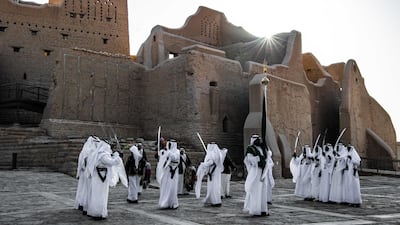Travel fatigue is a real thing in 2019. In the past two decades, the wonders of the internet have made the world feel ever smaller. That contraction has accelerated to the extent that ancient South-East Asian temples will be familiar to many people from Africa, Europe and the extremes of the Americas; and the byways of cities thousands of miles from your own can be navigated virtually via Google Street View. In short, most people already know what much of the rest of the world looks like, without even visiting.
So when a previously closed-off country begins a process of opening its borders to the world, it presents that rarest of opportunities for travellers: to tourist where few tourists have touristed before, seeing sights that are unknown to the majority of the planet's population en route. At-Turaif, a Unesco World Heritage Site on the outskirts of Riyadh, is one such location.
At-Turaif's history
It is remarkable for many reasons, not least that it is the original seat of power of Saudi Arabia's Al Saud family, who, thanks to rapid reforms attributed to Crown Prince Mohammed bin Salman, are now more visible on the world stage than ever before.
He recognises that the power of tourism has the potential to safeguard his country's economy, and has made it a key tenet of his Vision 2030. When Prince Mohammed visits At-Turaif on its opening weekend, he is mobbed by an adoring crowd of young Saudi citizens.
At-Turaif was founded in the 15th century, with much influence owed to the Najdi architectural style of Arabia. In the mid-18th century, the sprawling mud-brick city spawned the dynasty of Al Saud, who had lived in Ad Diriyah since the 15th century. The site had not been open to the public since it gained its Unesco designation in 2010, so its soft opening, before its full official launch later this year, is a real under-the-radar boon.
Saudi Arabia’s first 'gigaproject'
I receive a private early-morning tour on the weekend of At-Turaif's opening, which coincided with the first Formula E race in the country, held a short distance away on a street circuit temporarily constructed at Ad Diriyah.
The landscapes are starkly contrasting in an area that has been populated by nomadic people for many thousands of years.
The "E-Prix" is due to return to Riyadh, with a 10-year contract signed with the world's top electric-car race series – and thousands of people pass through At-Turaif's streets on that debut weekend, the first time that the Kingdom has granted tourist visas for non-religious purposes.
Hotels are scheduled to open in the surrounding area in 2020 as part of what has been dubbed Saudi Arabia's first "gigaproject", so now is perhaps your only opportunity to see At-Turaif before the crowds truly begin to arrive in the country.
Exploring the area
As you meander through its winding streets, historic noises are piped towards your ears, on loop, by cleverly hidden speakers. At first, I assume the hammering noises are modern-day workers putting finishing touches to the site; but the grunts and neighs of camels and horses that follow confirm that this is all part of the experience.
Unesco's strict rules on renovation of its sites mean that it is easy to differentiate the original structures of At-Turaif from the reinvigorated parts. By these regulations, the finish of the latter walls has to be smooth-sided, while the centuries-old sections retain a rough hue from years of weathering and the presence of fermented camel dung in the brick mix.

Where original walls have disappeared, it is predominantly down to conflict rather than climate – an impressive and lasting testament to the craftsmanship of its builders, given that hundreds of people once lived there. A routed and ruined mosque, plus cannonball marks, are stark reminders of an Ottoman invasion in the early 19th century. The Ottomans changed the course of Saudi history, with Ad Diriyah succeeded as the nation's capital by Riyadh. A smaller mosque remains, with prayer facilities for visitors.
The largest single structure in the city is Salwa Palace, which extends over approximately 10,000 square metres and consists of seven main units. The palace contains the Ad Diriyah museum, with more museums set to come.
Along the route, multilingual Saudi staff detail the minutiae of the history that has shaped At-Turaif’s storied past, with tours covering the entire site taking two hours.
Former villa residences that once housed families in 18th-and 19th-century At-Turaif have been converted into a souq, plus an array of cubbyhole areas where demonstrations of traditional crafts now take place – calligraphy, medicine, carpet weaving and the making of weapons are among the attractions. Again, all the staff are Saudis.
Beyond At-Turaif's walls lie further unrestored ruins that are due to be brought back to life and included in the site in the future. From its camel door at the main entrance – a shoulder-height opening through which those coming into the city would alight from their ships of the desert – to the modern-day additions, At-Turaif is a rare glimpse into life in Saudi Arabia in the past few centuries.
And for the time being at least, it proves a genuine bucket-list ticker.


